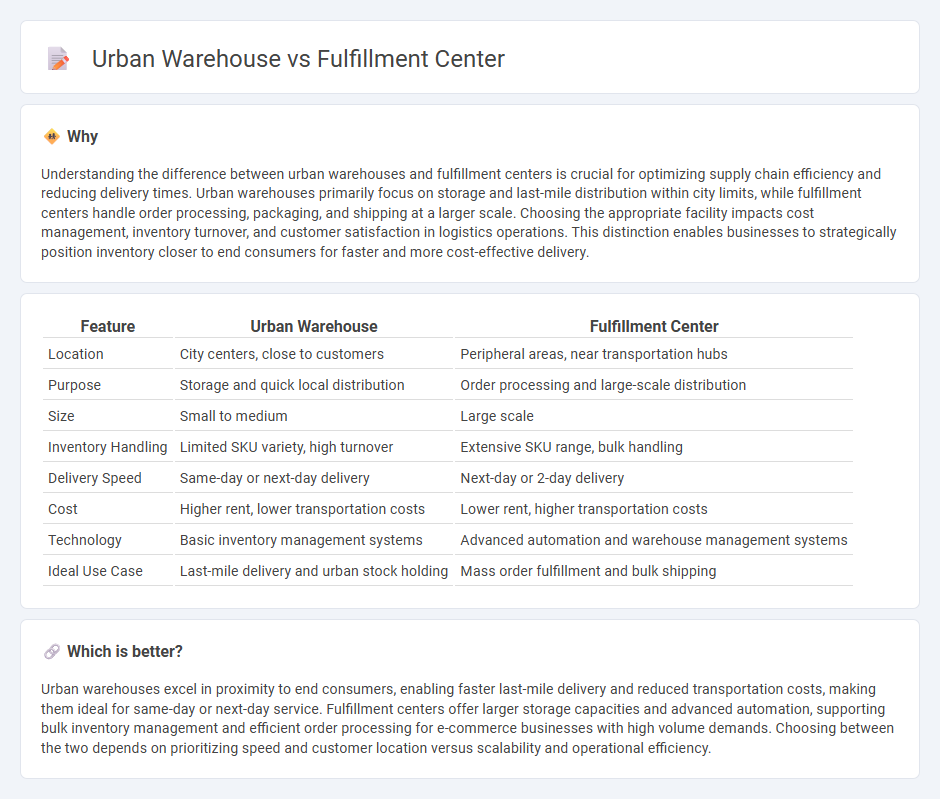
Urban warehouses focus on storing and distributing goods within city limits, enabling faster delivery and reducing transportation costs. Fulfillment centers specialize in processing orders, picking, packing, and shipping products directly to consumers, often supporting e-commerce operations. Explore more to understand how these facilities optimize supply chain efficiency in different urban environments.
Why it is important
Understanding the difference between urban warehouses and fulfillment centers is crucial for optimizing supply chain efficiency and reducing delivery times. Urban warehouses primarily focus on storage and last-mile distribution within city limits, while fulfillment centers handle order processing, packaging, and shipping at a larger scale. Choosing the appropriate facility impacts cost management, inventory turnover, and customer satisfaction in logistics operations. This distinction enables businesses to strategically position inventory closer to end consumers for faster and more cost-effective delivery.
Comparison Table
| Feature | Urban Warehouse | Fulfillment Center |
|---|---|---|
| Location | City centers, close to customers | Peripheral areas, near transportation hubs |
| Purpose | Storage and quick local distribution | Order processing and large-scale distribution |
| Size | Small to medium | Large scale |
| Inventory Handling | Limited SKU variety, high turnover | Extensive SKU range, bulk handling |
| Delivery Speed | Same-day or next-day delivery | Next-day or 2-day delivery |
| Cost | Higher rent, lower transportation costs | Lower rent, higher transportation costs |
| Technology | Basic inventory management systems | Advanced automation and warehouse management systems |
| Ideal Use Case | Last-mile delivery and urban stock holding | Mass order fulfillment and bulk shipping |
Which is better?
Urban warehouses excel in proximity to end consumers, enabling faster last-mile delivery and reduced transportation costs, making them ideal for same-day or next-day service. Fulfillment centers offer larger storage capacities and advanced automation, supporting bulk inventory management and efficient order processing for e-commerce businesses with high volume demands. Choosing between the two depends on prioritizing speed and customer location versus scalability and operational efficiency.
Connection
Urban warehouses and fulfillment centers are interconnected nodes in the logistics network that facilitate rapid order processing and last-mile delivery within metropolitan areas. Urban warehouses strategically store inventory closer to dense customer bases, reducing transportation time and costs for fulfillment centers managing e-commerce orders. This synergy enhances supply chain efficiency, minimizes delivery windows, and supports growing demand for same-day or next-day shipping services.
Key Terms
Order Processing
Fulfillment centers specialize in high-volume order processing by efficiently picking, packing, and shipping a wide range of products, often supporting e-commerce operations with advanced automation and inventory management systems. Urban warehouses offer faster local delivery speeds and cater to same-day or next-day delivery demands by strategically positioning inventory closer to densely populated areas, optimizing last-mile logistics. Explore how these facilities can enhance your order fulfillment strategy for improved customer satisfaction.
Proximity to End Customer
Fulfillment centers are typically located in suburban or rural areas, allowing for large-scale storage and efficient inventory management but farther from the end customer. Urban warehouses, positioned within city limits, prioritize proximity to customers for faster delivery times and improved same-day or next-day service. Explore how this strategic location impacts logistics and customer satisfaction.
Inventory Turnover
Fulfillment centers optimize inventory turnover by handling high-volume, large-batch shipments with longer storage times, streamlining order accuracy and reducing stock obsolescence. Urban warehouses improve inventory turnover through faster replenishment cycles and proximity to consumers, enabling just-in-time inventory and rapid distribution in dense population areas. Explore detailed comparisons on how fulfillment centers and urban warehouses impact inventory turnover rates for efficient supply chain management.
Source and External Links
Fulfillment Center & Warehousing Services: Tips and Tactics - A fulfillment center is a large facility where sellers or third-party logistics providers store inventory, pick, pack, and ship orders directly to customers or retailers, handling the entire order fulfillment process to improve efficiency and customer satisfaction.
What Is a Fulfillment Center? Everything You Need to Know - Fulfillment centers are third-party service providers that manage seller inventory and process orders using technology to efficiently pick, pack, and ship products directly to customers, playing a crucial role in e-commerce logistics.
Fulfillment Center vs. Warehouse: What's Best for You? - Fulfillment centers focus on real-time inventory management and order fulfillment tasks such as picking, packing, and shipping directly to consumers, enabling brands to scale by outsourcing these complex operations.
 dowidth.com
dowidth.com